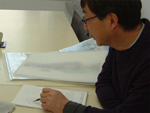“Emergent Grid”: A Conversation with Toyo Ito
Copyright Peter Macapia 2006
English Translation, Fumie Yamanaka and Daisuke Nagatomo
Photographs, Daisuke Hirose
Introduction
“Emergent grid.” This is a phrase Toyo Ito uses to describe the geometrical character of his recent work. It is one of the most important notions in characterizing the developments of late 20th and early 21st century architecture and its relation to engineering and structure. Geometry is an internal quality of structure. But in what sense is its pattern something already given? Consider Mies and Gaudi. Both modulate structural geometry. In Mies, this is defined by standardized dimensions and ideal proportions (and it is rectilinear). In Gaudi, it is derived from the behavior of matter, from funicular chains rather than imposed. These strategies point in opposite directions — of which one variant is the Greek trabeated system versus the Gothic vault. No one has yet split the difference, except Toyo Ito. The Brugge Pavilion, the Serpentine Pavilion, Todd’s, Mikimoto, etc.: these buildings have intense patterns. That’s the first thing that strikes me. The second is that each is very different in its structural innovation with regard to an unpredictable geometry. But there is a third and it this: the structure is constantly shifting. These features underscore a new relationship between pattern, geometry, and structure. This is where fluids come in. In the early nineties Ito wrote “On Fluid Architecture” in which he wanted to move beyond the history of architecture as static form, as idealized and conceptualized geometry. The mere suggestion of fluids introduces a unique perspective towards structure: architecture as an intense geometrical development of matter. Now between pattern and form, there is an incredible competition — patterns have infinite extension and form is bounded object — and between them Ito has found a way to establish an incredible “ecology.” It is a formidable challenge to the history of geometry in architecture.
Peter Macapia
I’m interested in how you’ve developed geometry over the last 10 years. Your buildings and your process are consistent in many ways but especially in this: there is a constant exploration of the modulation and continuity of structure.
Toyo Ito
I have been interested [for many years] in getting design inspiration from the phenomena of fluids, of things moving. In the 90’s I designed or composed with pure geometrical shapes. For example, I would connect several points of one part of a geometrical shape with another. I used simple geometrical shapes was because I was always having difficulty with structural simulations. However, since 2000, I have been using advanced structural analysis tools. We can simulate not only regular geometrical forms, but any surface with computers. These tools allow me to figure out problems and modify them until I find an appropriate structure. At the same time, as a designer in this process, it is difficult to choose between a structure “A” and a structure “B” because there is no specific reason I have to pick between those two. So, at this moment, I am still trying to find the “rules” to create “form.”
Macapia
Do you mean that in the shift away from geometrical forms and solids – what you call shapes — you are looking at “rules” for a particular logic of organization, for example the continued emphasis on things like grids?
Ito
I don’t know if it is logic or not. [Ito goes to get analytical model]
In this experiment, I was especially interested in creating complex geometry out of a simple grid. I attempted to control the grid according to the programs by changing the scale and create three-dimensional surfaces [here Ito raises the top grid of the model which is connected to a lower grid by a sheet of mesh, then the mesh distorts into a complex three dimensional grid that connects regular two dimensional grids of the top and bottom] . I’m not sure it is logic that I am looking for . . .The [complex] three dimensional grid is the result of an experiment with the simple grid for the structural system –I would call that system an emerging grid.
